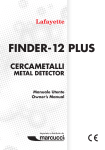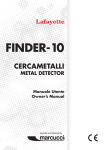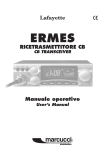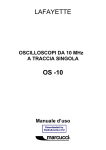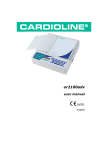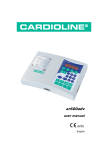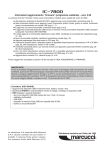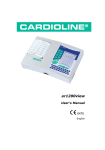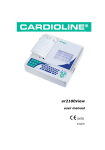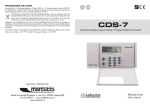Download Finder-18S POINT
Transcript
Finder-18S POINT Cercametalli Metal Detector Manuale Utente Owner’s Manual Importato e distribuito da Con il vostro metal detector è possibile ricercare monete, resti, gioielli, oro e argento quasi in ogni luogo. Il detector è versatile e facile da utilizzare. Tra le caratteristiche del detector ci sono: •Targeting - Per localizzare il target accuratamente abbassando la sensibilità. •Tone - Utilizza un suono distinto per ogni tipo di metallo. •All Metal - Per la ricerca di oggetti fatti con qualsiasi tipo di metallo. •Misuratore analogico - Mostra i probabili tipi di metallo che vengono rilevati. •Aggiustamento della Frequenza - Per impedire che ci siano interferenze dovute a dispositivi che hanno la stessa frequenza. •Supporto a Braccio - Per facilitare il trasporto e l’utilizzo del dispositivo. •Presa per cuffie - Permette di collegare le cuffie (non fornite) e operare senza problemi. •Bobina di ricerca Impermeabile - Permette di utilizzare il dispositivo anche sotto l’acqua. •Asta regolabile - Permette di regolare la lunghezza del detector per facilitare l’utilizzo. •Indicatore di Batteria Scarica - Indica quando è il momento di cambiare la batteria. •Potenza - Richiede due batteria alcaline a 9 volt (non fornite). Inserire un circuito c.c. - c.c. impedisce di connettere in modo errato la polarità della batteria prolungando la durata della batteria stessa. PREPARAZIONE ASSEMBLARE IL DETECTOR L’assemblaggio del detector è semplice e non richiede attrezzature particolari. Basta seguire le fasi seguenti. 1. Girare il dado autobloccante dell’asta in senso orario finché non si allenta. 2. Allungare o accorciare in modo che quando vi trovate in piedi con il detector in mano, la bobina sia in posizione orizzontale a circa 1-5 cm da terra e il braccio sia rilassato lungo il fianco. 3. Girare il dado autobloccante in senso antiorario per bloccare in quella posizione. 4. Svitare la manopola sulla bobina di ricerca e rimuovere il connettore. Inserire l’asta e allineare i buchi sul sostegno della bobina a quelli dell’asta. Spingere il connettore attraverso i buchi e stringere la manopola. 5. Avvolgere il cavo della bobina intorno all’asta. Lasciare il cavo abbastanza lento. 6. Inserire la spina della bobina nella presa apposita nella scatola dei comandi del detector. 1 Attenzione: La spina della bobina entra nel connettore in un solo modo. Non forzare la spina o potrebbe danneggiarsi. 7. Allentare la manopola situata alla fine della bobina di ricerca, poi regolate la bobina con l’angolo desiderato in modo che sia parallela al terreno. Poi stringete la manopola. Attenzione: Non stringere eccessivamente la bobina di ricerca o non utilizzare utensili come le pinze per stringerla. 8. Inserire il supporto a braccio all’estremità dell’asta e stringere la vite di chiusura. COLLOCARE LE BATTERIE Attenzione: •Utilizzare solo batterie alcaline nuove e della misura richiesta. •Non mescolare le batterie nuove con quelle vecchie o diversi tipi di batterie. 1. Impostare l’interruttore su OFF. 2. Fare scorrere i coperchi destro e sinistro della batteria nella direzione della freccia. 3. Sistemare la batteria a 9V nel vano batteria facendo corrispondere i simboli di polarità (+ e -) indicati all’interno. Attenzione: Sistemare le vecchie batterie prontamente e in modo corretto. Mai sotterrare o bruciare le batterie. Attenzione: Rimuovere le batterie se si prevede di non utilizzare il dispositivo per una settimana o più. Dalle batterie può fuoriuscire materiale chimico che può rovinare i componenti elettronici. Per allungare la durata della batteria, scambiare quella a destra con quella a sinistra dopo 3-4 ore di utilizzo. 2 UTILIZZO DELLE CUFFIE 1. Inserire la spina delle cuffie 3,5mm nel jack CUFFIE. A quel punto gli altoparlanti interni si disconnettono. 2. Regolare il VOLUME al livello desiderato. Ascolto Sicuro •Per proteggere l’udito, impostare il volume al livello più basso prima di iniziare l’ascolto, poi regolarlo a un livello confortevole. •Non ascoltare a livelli estremamente alti. Un ascolto prolungato a volume molto alto può causare la perdita permanente dell’udito. •Non indossare le cuffie quando si opera in zone vicine a traffico intenso. Prestare attenzione alla sicurezza stradale. RAPIDO SGUARDO AL DETECTOR Selettore modalità Regolazione volume Selettore DISC/TONE Target Pin Pointing Misuratore Analogico Batteria in esaurimento Regolatore di Frequenza Sensibilità Cuffie 3 COMANDI & INDICATORI A Modalità Operative •“OFF” - Spento. •“DISC” - Modalità discriminazione. Funziona con DISC/TONE. Differenzia il tipo di metallo in base al tono. •TONE - Funziona con DISC/TONE. Emette due suoni distinti per tipi diversi di metallo. •ALL METAL - in questa modalità, il detector può rilevare ogni tipo di metallo con qualsiasi impostazione DISC/TONE. B VOLUME - Si può impostare il volume al livello desiderato da BASSO ad ALTO C. DISC/TONE Si può impostare l’interruttore alla posizione desiderata ruotandolo da “0”~”10”. Quando si è in modalità DISC, il dispositivo discrimina i tipi di metallo a seconda della lunghezza del suono che emette. Quando è in modalità TONE, il detector discrimina i tipi di metallo come per il volume del suono. D. Localizzazione del Target Premere il bottone rosso in alto sul manico per abbassare la sensibilità al fine di identificare i target in modo più accurato. E. AUDIO” jack Per collegare le cuffie alla spina AUDIO, gli altoparlanti interni verranno disconnessi. F. SENSIBILITÀ Ruotare su una posizione da “0” a “10”. La sensibilità più bassa corrisponde alla posizione “0” e la più alta è in posizione “10”. Ruotare la SENSIBILITÀ alla posizione più alta mentre si cercano i target; impostarla alla posizione più bassa quando si ricerca in suoli altamente mineralizzati o in aree con elevate interferenze elettroniche e il metal detector non funziona stabilmente. G. FREQ ADJ Aggiustare la sensibilità con FREQ ADJ per evitare le interferenze di altri metal detector presenti nella stessa zona. H. LOW BAT L’indicatore di LOW BAT si accende quando è il momento di cambiare le batterie. I. Misuratore Analogico Quando il metal detector trova un target di metallo, l’indicatore del misuratore gira verso destra. 4 Funzionamento Il dispositivo Finder-18S Point ha quattro modalità operative: DISC、TONE 、ALL METAL e TARGET TRACK. DISC E TONE sono modalità di movimento mentre TARGET TRACK è una modalità statica. Durante la ricerca, generalmente impostare la modalità operativa su “DISC” e sulla posizione di alta sensibilità e regolare “DISC/TONE” a “0”. Far scorrere la bobina come mostrato nella figura seguente, muovere la bobina indietro e avanti seguendo una linea ad arco. Per non perdere alcun target, è importante mantenere una distanza dal terreno di almeno 1-5 cm (più vicino al terreno per i target più piccoli) e una distanza tra due archi vicini di circa 10-15 cm. Se si sente un suono “di-di” durante il movimento, esso indica che c’è un target di metallo nell’area sondata. In questo caso, è possibile utilizzare “LOCALIZZAZIONE TARGET” per localizzare il target. Poi utilizzare “DISC” o “DISC/TONE” per determinare se vale la pena estrarre il target. Qui di seguito vengono presentate le quattro modalità operative in dettaglio. LOCALIZZAZIONE DEL TARGET Se si sente un suono “di-di” durante la ricerca in DISC, esso indica che c’è un target di metallo nell’area sondata. In questo caso, è possibile utilizzare “LOCALIZZAZIONE TARGET” per localizzare il target. Tenere la bobina a 50 o più cm da terra. Tenere premuto il bottone LOCALIZZAZIONE TARGET, un bottone rosso in cima al manico. Far scorrere la bobina sull’area sondata e rilasciare il bottone quando si sente il suono “di-di”. Dopo circa 1-2 secondi, tenere nuovamente premuto il bottone rosso, il suono “di-di” scompare (ciò significa che il target è lontano dalla bobina). In questo caso, avvicinando la bobina alla terra si sentirà nuovamente il suono. Ripetere le fasi precedenti finché non viene trovato il target, Dopo averlo trovato, scegliere tra le tre seguenti modalità operative per determinare di quale tipo di metallo si tratta, DISC Impostare l’interruttore di modalità su DISC e DISC/TONE su “0”. L’unità risponderà con un lungo “di-di” sia per metalli ferrosi che per metalli non ferrosi. Girare il DISC/TONE in senso orario in una posizione prossima al 5. Si udirà un “di-di” corto per target in ferro o nichel. Mentre si udirà un “di-di” lungo per target in rame o argento. Girare l’interruttore in senso orario in una posizione prossima al 10. Quasi nessun suono sarà percepibile per target in ferro o nichel. Mentre un “di-di” corto è percepibile per il rame. Ancora un suono lungo invece per i target in argento. Tuttavia ci vuole molta pratica per ottenere una rilevazione accurata. TONE Impostare l’interruttore di modalità su TONE e DISC/TONE su “0”. L’unità risponderà con un forte segnale acustico sia per metalli ferrosi che per metalli non ferrosi. Un segnale basso indica i metalli mineralizzati, Girare l’interruttore in senso orario in prossimità della posizione 5. L’unità risponderà con un segnale basso per il ferro. Ma un misto di segnali alti e bassi indica la presenza di nichel. Un segnale di tonalità media indica un target in rame. Una tonalità alta indica l’argento. Girare l’interruttore in prossimità della posizione 10 sia i metalli ferrosi che il nichel verranno indicati da 5 una bassa tonalità. Ma un misto di segnali alti e bassi indica il rame. Una tonalità alta indica l’argento. Ci vuole molta pratica per ottenere una rilevazione accurata. Durante la pratica è importante prendere appunti. ALL METAL Impostare l’interruttore di modalità su ALL METAL e DISC/TONE su una posizione qualsiasi. L’unità risponderà con un suono per tutti i metalli. Note: •Se ci sono interferenze dovute ad altri strumenti o cavi elettrici o di TV e radio nell’area di ricerca, regolare FREQ ADJ in un’altra posizione o abbassare la sensibilità, oppure cambiare l’attuale area di ricerca. •Quando si ricerca in una zona altamente mineralizzata, l’unità suonerà anche se non ci sono metalli. In questo caso, si può abbassare la sensibilità e aumentare l’altezza tra la bobina e il terreno finché non sparisce il falso segnale. Se necessario, resettare DISC/TONE. •Quando si ricerca in aree con rifiuti, è meglio impostare DISC/TONE in posizione 5, in modo che l’unità possa segnalare molti dei metalli comuni come chiodi o piccoli scarti di ferro. •Rimuovere qualsiasi attrezzo metallico per lo scavo durante la ricerca, •È possibile ricercare target di tutti i metalli con “ Localizzazione del target”. Ma se si sta cercando un target piccolo in un luogo dove è stato sepolto un grosso oggetto metallico. Compariranno falsi segnali. In questo caso, rimuovere il grosso oggetto metallico. •Il livello di sensibilità è generalmente in contraddizione con quello della discriminazione. Più è alto il livello di sensibilità, peggiore sarà la discriminazione. Ma è possibile abbassare la sensibilità per avere una migliore differenziazione. •Si può muovere la bobina in orizzontale o verticale e fare una croce sul punto sondato. CURA E MANUTENZIONE Il metal detector FINDER-18S POINT è un esemplare di raffinata fattura e design. I seguenti suggerimenti saranno d’aiuto per la cura del metal detector per renderlo fruibile per molti anni. Maneggiare il detector con delicatezza e attenzione. Le cadute possono danneggiare le piastre dei circuiti e le scatole e possono causare un funzionamento improprio del dispositivo. Utilizzare il detector soltanto in ambienti a temperatura normale. Temperature estreme possono accorciare la durata dei dispositivi elettronici, danneggiare le scatole del detector. Tenere il detector lontano da polvere e sporcizia poiché possono causare l’usura prematura delle sue parti. Pulire il detector con un panno umido saltuariamente per farlo sembrare ancora nuovo. Per pulire il detector non utilizzare sostanze corrosive, solventi per la pulizia o detergenti forti. 6 With your metal detector, you can hunt for coins, relics, jewelry, gold, and silver just about anywhere. The detector is versatile and easy to use. The detector’s features include: •Targeting - To pinpoint the target accurately by lowering the sensitivity. •Tone - Sounds distinctive tones for different types of metal. •All Metal - To search for all kinds of metal object. •Analog Meter - Shows probable type of metal being detected. •Frequency Adjustment - to avoid interference from other equipment with same frequency. •Arm Support - Lets you carry and operate your detector comfortably. •Headphone Jack - Lets you connect headphones (not supplied) and operate without trouble. •Waterproof Searchcoil - Lets you use the detector even if you must put it under water. •Adjustable Stem - Lets you adjust the detector’s length for comfortable use. •Low Battery Indicator - Lets you know when it is time to replace the batteries. •Power - Your metal detector requires two 9-volt alkaline batteries (not supplied). The built in DCDC circuit can avoid wrong battery polarity connection and prolong the battery life. PREPARATION ASSEMBLING THE DETECTOR Assembling your detector is easy and requires no special tools. Just follow these steps. 1. Turn the stem’s lock nut clockwise until it loosens. 2. Lengthen or shorten so when you stand upright with the detector in your hand, the search coil is level with and about 1/2 to 2 inches above the ground with your arm relaxed at your side. 3. Turn the stem’s lock nut counter-clockwise to lock it in place. 4. Unscrew the knob on the search coil and remove the knob connector. Insert the stem and align the holes on the search coil bracket and the stem. Push the connector through the holes and tighten the knob. 5. Wind the search coil cable around the stem. Leave enough slack in the cable. 6. Insert the search coil’s plug into the search coil jack on the detector’s control housing. Caution: The search coil’s plug fits into the connector only one way. Do not force the plug or you could damage it. 1 7. Loosen the knob at the search coil’s end, then adjust the search coil to the desired angle so that it is parallel with the ground. Then tighten the knob. Caution: Do not overtighten the search coil or use tools such as pliers to tighten it. 8. Insert the arm support into the end of the stem and tighten the lock screw. INSTALLING THE BATTERIES Caution: •Use only fresh alkaline batteries of required size. •Do not mix the old and new batteries or different types of batteries. 1. Set the mode switch to OFF. 2. Slide the left and right battery covers off in the direction of the arrow. 3. Place a 9V battery into the battery compartment matching the polarity symbols (+ and -) marked inside. Warning: Dispose of old batteries promptly and properly. Never bury or burn them. Caution: If you don’t plan to use the unit for a week or more time, remove the batteries. Batteries can leak chemicals that can destroy electronic parts. To extend the battery life, exchange the left and right battery after 3~4hours of operation. 2 USING HEADPHONES 1. Insert the headphones’ 3.5mm plug into the HEADPHONE jack. At this time the internal speaker disconnects. 2. Set the VOLUME to the desired setting. Listening Safely To protect your hearing, set the volume to the lowest setting before you begin listening, adjust the volume to a comfortable level. Do not listen at extremely high volume levels. Extended high volume listening can lead to permanent hearing loss. Do not wear headphones while operating your detector near high-traffic areas. Pay attention to traffic safety. A QUICK LOOK AT THE DETECTOR Mode Switch Volume DISC/TONE Target Pin Pointing Analog Meter Low Battery Frequency adjustment Sensitivity Headphone 3 CONTROLS & INDICATORS A Operating Modes •“OFF” - Power off. •“DISC” - Discrimination mode. Works with DISC/TONE. Discriminates the metal type based on the tone. •TONE - Works with DISC/TONE. Sounds two different tones for different types of metal. •ALL METAL - In this mode, the detector can detect all kinds of metal with any setting of DISC/TONE. B. VOLUME - You can set the volume to the desired level from LOW to HIGH. C. DISC/TONE You can set the mode switch to any desired position from rotating it from “0”~”10”. When in DISC mode, the detector discriminates the metal type according to the length of the tone it sounds. When in TONE mode, the detector discriminates the metal type as per the volume of the tone. D. Target Pinpointing Press the red button at the top of the handle to lower the sensitivity in order to pin-point targets more accurately. E. PHONE” jack Connect earphone to the PHONE jack, speaker inside will be disconnected. F. SENSITIVITY Turn to any position from “0” to “10”. Get lowest sensitivity in “0” position and highest sensitivity in “10” position. Turn SENSITIVITY to higher position when searching targets; Turn SENSITIVITY to lower position when searching in highly mineralized soil or high electronic interference area and the metal detector is not working stablly. G. FREQ ADJ. Adjust sensitivity with FREQ ADJ to avoid interference from any other metal detector in the same area. H. LOW BAT The LOW BAT indicator lights to indicate it’s time for user to replace the batteries. I. Analog Meter When the metal detector finds a metal target, the meter pointer will turn to right. 4 Operation Your Finder-18S Point has four operation modes: DISC-TONE/ALL METAL and TARGET TRACK. DISC and TONE are motion modes while TARGET TRACK is a non-motion mode. When searching, generally set operation mode to “DISC” and to high sensitivity position and set “DISC/TONE” to “0”. Sweep your search coil as following picture, move the search coil back and forth in an arc line. For not missing any target, it is better to keep the distance from search coil to the earth about 1 - 5 cm (closer to the earth for smaller target) and the distance between two neighboring arcs 10 – 15cm. If there is a sound of “di-di” during moving, it indicates that there is a metal target in the sound area. In this case, you can use “TARGET PINPOINTING” to pin-point the target. Then use “DISC” or “DISC/TONE” to determine whether the target is worth digging out. The followings are the four operation modes in detail. TARGET PINPOINTING If there is a sound of “di-di” during searching in DISC, it indicates that there is a metal target in the sound area. In this case, you can use “TARGET PINPOINTING” to pin-point the target. Hold the search coil 50cm or more away from the earth. Hold down the TARGET PINPOINTING button, a red button at the top of the handle. Sweep the search coil over the sound area and release the button when you hear a sound of “di-di”. After about 1~2 seconds, hold down the red button again, The “di-di” sound disappears (this means the target is far away from the search coil). In this case, closer the search coil to the earth and you’ll hear the sound again. Repeat the above steps until you find the target. After you find the target , make a choice from the following three operating modes to determine which kind of metal the target is. DISC Set the mode switch to DISC and DISC/TONE to “0”. The unit will respond with a long “di-di” sound to both ferrous metal and non-ferrous metal. Turn the DISC/TONE clockwise to the position near 5. A short “di-di” sound will be heard for iron and nickel target. But a long “di-di” sound is for copper and silver target. Turn the switch clockwise to the position near 10. Almost no sound will be heard for iron and nickel target. But a short “di-di” sound is for copper. Still a long sound is for silver target. However it needs more practices to have an accurate detection. TONE Set the mode switch to TONE and DISC/TONE to “0”. The unit will respond with a high tone to both ferrous and non-ferrous metals. A low tone is for mineralized metals. Turn the switch clockwise to the position near 5, The unit will respond with a low tone to iron. But a mixture of high and low tone is for nickel. A medium high tone indicates a copper target. A high tone is for silver. Turn the switch to the position near 10, both ferrous and nickel metal will be indicated by a low tone. But a mixture of high and low tone is for copper. A high tone is for silver. It also needs more practices to have an accurate detection. And make notes during practice. 5 ALL METAL Set the mode switch to ALL METAL and the DISC/TONE to any position. The unit will respond with a tone to all metal. Notes: •If there are interference from other instruments or electrical cable or TV or radio in your searching area, set the FREQ ADJ to other position or to lower the sensitivity, or to change the current searching area. •When searching in highly mineralized area, the unit will sound even if there’s no metal. In this case, you can lower the sensitivity and increase the height between the search coil and the ground until the false signal disappears. If necessary, reset the DISC/TONE. •When searching in trash area, it’s better to set the DISC/TONE to 5 position, so that the unit can notch most of invaluable metals such as nails and small trashy iron. •Move away any metal digging tool when searching. •You can search for all metal targets with “Target Pin-pointing”. But if you’re searching for small target near where a large metal object is buried. False signal will appear. In this case, remove the large metal object. •Sensitivity level is generally in contradiction with that of the Discrimination. The higher the sensitivity level is, the worse discrimination will be. But you can lower the sensitivity to have better discrimination. •You can move the search coil horizontally and vertically and make a cross at the sound point. CARE AND MAINTENANCE •Your FINDER-18S POINT metal detector is an example of superior design and craftsmanship. The following suggestions will help you care for your metal detector so you can enjoy it for years. •Handle the detector gently and carefully. Dropping it can damage circuit boards and cases and can cause the detector to work improperly. •Use the detector only in normal temperature environments. Temperature extremes can shorten the life of electronic devices, damage the cases of the detector. •Keep the detector away from dust and dirt, which can cause premature wear of parts. •Wipe the detector with a damp cloth occasionally to keep it looking new. Do not use harsh chemicals, cleaning solvents, or strong detergents to clean the detector. 6 INFORMAZIONE AGLI UTENTI Ai sensi dell’art. 13 del decreto legislativo 25 luglio 2005, n. 15”Attuazione delle Direttive 2002/95/CE, 2002/96/CE e 2003/108/CE, relative alla riduzione dell’uso di sostanze pericolose nelle apparecchiature elettriche ed elettroniche, nonché allo smaltimento dei rifiuti” Il simbolo del cassonetto barrato riportato sull’apparecchiatura indica che il prodotto alla fine della propria vita utile deve essere raccolto separatamente dagli altri rifiuti. L’utente dovrà, pertanto, conferire l’apparecchiatura giunta a fine vita agli idonei centri di raccolta differenziata dei rifiuti elettronici ed elettrotecnici, oppure riconsegnarla al rivenditore al momento dell’acquisto di una nuova apparecchiatura di tipo equivalente, in ragione di uno a uno. L’adeguata raccolta differenziata per l’avvio successivo dell’apparecchiatura dismessa al riciclaggio, al trattamento e allo smaltimento ambientalmente compatibile contribuisce ad evitare possibili effetti negativi sull’ambiente e sulla salute e favorisce il riciclo dei materiali di cui è composta l’apparecchiatura. Lo smaltimento abusivo del prodotto da parte dell’utente comporta l’applicazione delle sanzioni amministrative di cui al dlgs. n. 22/1997” (articolo 50 e seguenti del dlgs. n. 22/1997). USER INFORMATION in accordance with art. 13 of the Legislative Decree of 25th July 2005, no. 15 ”Implementation of Directives 2002/95/ EC, 2002/96/EC and 2003/108/EC, relative to reduction of the use of hazardous substances in electrical and electronic equipment, in addition to waste disposal” The crossed bin symbol shown on the equipment indicates that at the end of its working life the product must be collected separately from other waste. The user must therefore take the above equipment to the appropriate differentiated collection centres for electronic and electro technical waste, or return it to the dealer when purchasing a new appliance of equivalent type, in a ratio of one to one. Appropriate differentiated waste collection for subsequent recycling, treatment and environment-friendly disposal of the discarded equipment helps to prevent possible negative environmental and health effects and encourages recycling of the component materials of the equipment. Illegal disposal of the product by the user will be punished by application of the administrative fines provided for by the legislative decree no. 22/1997 (article 50 and following of the legislative decree no. 22/1997). 7 Imported and distributed by S. P. Rivoltana 4 - km 8,5 • 20060 Vignate (MI) [email protected] • www.marcucci.it
















